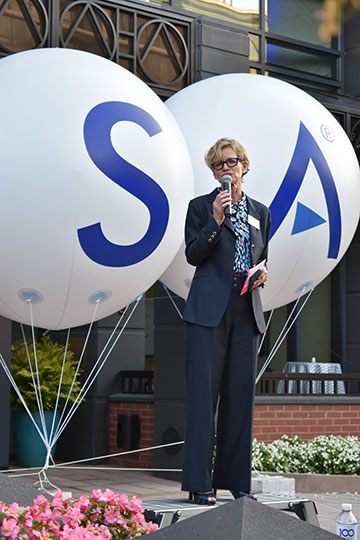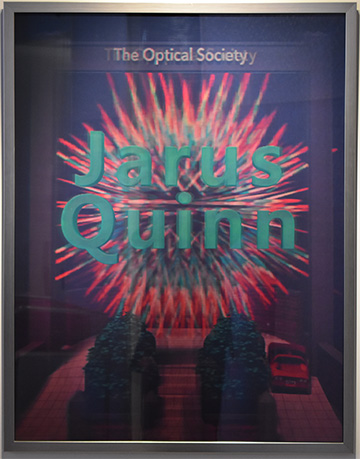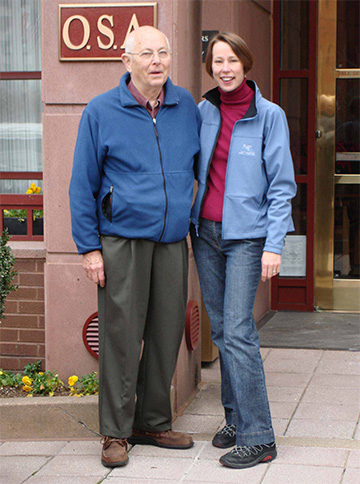![]()
The Optical Society’s front entrance now prominently honors a key figure in the organization’s growth.
OSA marked the first day of Frontiers in Optics 2017 in a particularly meaningful way: By formally dedicating its newly renovated headquarters building in Washington, D.C., in honor of Jarus W. Quinn, who served as the society’s first executive director from 1972 to 1994. The building’s dedication, originally announced last December, adds the name of Quinn prominently to the official front door of The Optical Society—an organization that owes much of what it is today to changes during Quinn’s tenure.
Balloons, art and a holographic Corvette
The christening ceremony for the Jarus W. Quinn Building—which underwent a top-to-bottom revamp during 2016 and early 2017—began outside of the building, which was temporarily adorned by a display of three giant balloons spelling “OSA.” As the balloons swayed in a sometimes brisk wind, a variety of luminaries, including past OSA presidents and officers, emeritus employees, and longtime OSA volunteers, mingled with current staff and with members of Quinn’s extended family.

OSA chief executive Elizabeth Rogan honored Quinn’s accomplishments in remarks before a large “OSA” balloon display.
OSA’s chief executive, Elizabeth Rogan, remembered Quinn’s contributions, alluding to OSA’s recent Centennial celebration. “He wanted this organization to live way past a hundred, and here we are today,” Rogan said. She cited Quinn’s accomplishments in helping to create a sustainable, internally managed publishing operation, increasing the organization’s financial strength, and boosting its influence worldwide. “He did such a great job in increasing our global influence, that more than half of our members now are from outside of the U.S.,” she observed.
Inside of the building’s lobby, the attendees were greeted by a newly installed, commissioned art exhibition, “Infinite Possibilities,” by the British artist Bruce Munro. Visitors to the lobby will also now see another commissioned artwork—a commemorative Jarus Quinn hologram created in a joint collaboration by OSA, Upwell Group, Forth Dimension Holographics, and GEOLA Digital. The hologram was created via a technique that uses RGB pulsed lasers to write color-reflection holograms as 1.6-mm-diameter “holopixels,” and that stitches them together with 3-D computer modeling software to create large holographic displays. The hologram’s creators added a particularly personal nod to Quinn: His fondly remembered red Corvette sits in the lower right area of the hologram.

A new Jarus Quinn commemorative hologram—complete with Quinn’s beloved red Corvette in the lower-right corner—now hangs in the lobby of the building that bears his name.
Honoring a change agent
Quinn, a spectroscopist, joined the society’s staff in 1969 to assist then–executive secretary Mary Warga with managing the affairs of a rapidly growing organization. When Warga retired in 1972, Quinn took over her role under the new title of executive director. During his 25-year tenure at OSA, he oversaw dramatic expansion of the organization’s staff size (which moved from 7 employees to 90) and its budget (which expanded from US$1 million to US$10 million).
Quinn guided OSA into the personal-computer era and to the threshold of the internet age, and spurred the society to move its journal-publishing operation, previously managed by the American Institute of Physics, completely in-house, setting up its subsequent years of rapid growth. (In 1975, he also helped to found Optics News, the precursor of the publication you’re reading now.) Quinn’s tenure saw the launch of two meetings fundamental to OSA’s contemporary identity, CLEO and OFC, as well as a range of other OSA topical meetings. And he worked to advance the society’s financial strength and to boost its presence outside of the United States.
Finding homes for OSA

Jarus Quinn with his daughter, Kristin Quinn, outside of the OSA headquarters building (sporting its previous nameplate) in 2007.
Quinn—who stepped down as executive director in 1994, to be succeeded by Rogan in 2002—has already received a number of honors from the society. In addition to being recognized as an OSA Fellow in 1969 and subsequently receiving the society’s Distinguished Service Award, an endowment was set up in his name upon his retirement to fund the society’s most prestigious award, which was renamed the Frederic Ives Medal/Jarus W. Quinn Prize. In 2011, a year before his death, Quinn became an OSA Honorary Member, the society’s highest distinction.
Yet the dedication of OSA’s headquarters in Quinn’s name seems particularly appropriate, as Quinn was an active player in OSA’s first move to a permanent building owned by the society. As described in an OPN article by former OSA President John Howard, Quinn—recognizing that the society had outgrown its earlier digs in the early 1970s—“quickly acquired an understanding of areas that included real estate, zoning and fundraising,” an arcane set of domains to say the least.
The effort culminated in the society’s move in 1979 to its first permanent home at 1816 Jefferson Place in Washington, D.C. OSA would remain there for another ten years. At that point, Quinn, along with OSA’s finance director, Jennifer Leah Horton, oversaw the firm’s relocation yet again, to its current address at 2010 Massachusetts Avenue NW in Washington, D.C.—the building that now bears his name.
